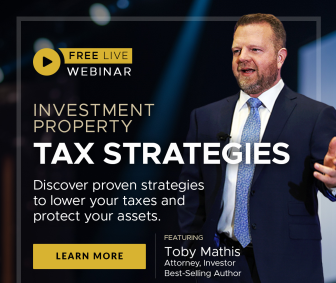
REtipster does not provide tax, investment, or financial advice. Always seek the help of a licensed financial professional before taking action.
You’ve heard the line a hundred times:
“It takes money to make money.”
And nowhere does it seem truer than in real estate investing, where a down payment alone can set you back $50,000.
Yet somehow, people get started in real estate every day with little cash to their name.
How do they do it? If you aren’t swimming in gold coins, fret not. You have plenty of options at your disposal.
Here’s how to invest in real estate with very little money, and remember — with each new cash flowing property you acquire, you'll effectively start snowballing your income and making it all the easier to buy your next one.
How to Invest in Real Estate With Little Money: 11 Tactics
You don’t need a fortune to invest in real estate, but you do generally need something. While a few savvy investors figure out how to invest in real estate with no money, most strategies require at least a little bit of working capital.
Start with one of these tactics as you explore how to invest in real estate with little money, and use it as a stepping stone into the world of real estate investing.
1. House Hack
House hacking comes with many advantages and few disadvantages and offers an excellent first real estate investment with little money down.
There are many ways to house hack, but the classic strategy works as well as any. With it, you buy a small (2-4 unit) multifamily, move into one unit, and rent out the other(s). The idea is that your neighboring tenants’ rent covers your mortgage payment and ideally some maintenance costs, so you effectively get free housing.
Eliminating your housing payment goes a long way in helping you save money faster for your next down payment. But you gain another benefit as well: you can take out an owner-occupied mortgage, with a down payment as low as 3%.
Contrast that against your typical investment property loans, which require 20-30% down. With owner-occupied financing, you can cut your down payment to a tenth of what you’d need otherwise!
If you have strong credit, check out Fannie Mae’s HomeReady and Freddie Mac’s Home Possible loan programs, which both start their down payments at 3%. Borrowers with weaker credit can turn to an FHA loan if necessary, although FHA loans no longer let borrowers remove the mortgage insurance premium even after paying their balance below 80% of the property value.
2. Rotate Your Homes Into Rental Properties
Along similar lines, you can use owner-occupied financing to buy a single-family home, live there for a year — the minimum required by lenders — and then move out, keeping the property as a rental. This way, you can build a portfolio of rentals, each with little of your own money tied up.
Not only do you score a low down payment, but you also qualify for a much lower interest rate with owner-occupied mortgages, helping to buoy your cash flow.
Unfortunately, this strategy comes with two significant drawbacks. First, it limits your pace to one property per year at most. But even more problematic, these mortgages appear on your personal credit report.
Piling up three or more mortgages can not only hurt your credit, but most conventional lenders place a cap on how many mortgages they allow you to report on your credit before they stop lending to you. For most loan programs, that cap sits at four mortgages. After that, game over for conventional mortgages.
3. House Hack Through Your Children
If your children have reached their young adulthood, you can go in on a property with them, and they can meet the occupancy requirement. You don’t have to move in, only they do, yet you still get an owner-occupied mortgage.
Often called a “kiddie condo loan,” it allows parents to effectively house hack through their children.
Imagine it: you and your child buy a three-bedroom house or apartment, or even a three-unit property. They move into one bedroom and rent out the others to friends or classmates (possibly with their parents cosigning the lease). Your child could also pay you rent, and perhaps manage the unit for you in exchange for reduced rent.
Eventually, they move out, and you keep the property as a rental.
Of course, you don’t have to be the parent in this transaction. If you’re a young adult exploring how to invest in real estate with little money, you could approach your parents to go in on the property with you. How much you put down, how much rent you pay, and your property management responsibilities are all negotiable.
4. Do a Live-In Flip
Continuing the theme of owner-occupied financing, consider flipping properties the slow way.
It works like this. You buy a property that needs renovation work and takes out either a conventional loan if the property is habitable or a 203K loan if not. In this way, you secure a low down payment and interest rate.
If the property was not deemed habitable by the appraiser, you do the renovations before moving in; if habitable, you can move in immediately and gradually make a home improvement on your own schedule. Your spouse may come to hate the constant sound of a circular saw running, but that’s the price of a live-in flip.
After a year or two, you sell your newly upgraded property for a profit. Which you can turn around and use to invest in an income-producing property to snowball your income, or put toward flipping a house, or however else you see fit to reproduce your money.
Alternatively, you could move out of the property and keep it as a rental, building your portfolio that way.
5. Draw on Credit Lines
If you’re short on cash for a down payment, you could potentially borrow it from a credit line.
Credit lines come in several shapes and sizes, from home equity lines of credit — available against both your primary residence and your rental properties — to unsecured business credit lines. You can also use business credit cards or even personal credit cards to draw cash and avoid the cash advance fee and limit through a service like Plastiq.
A few words of caution, however. First, this method doesn’t work with owner-occupied mortgages, as they don’t allow any part of the down payment to be borrowed. It does work with most portfolio lenders, however.
Second, investors must be extremely careful not to overleverage themselves and end up with negative cash flow. Run your cash-on-cash return numbers carefully, and use conservative estimates for both income and expenses.
6. Find an Investing Partner
Don’t have much capital to invest? Partner with someone who does. Ideally, someone who already knows the ropes of real estate investing, so they can help you steer around pitfalls and show you a trick or two along the way.
Partnering on real estate joint ventures comes with plenty of other perks too, such as leveraging the partner’s existing network of contractors, lenders, and so forth. But it comes with one giant risk: the risk of a dishonest or incompetent partner. When you partner with someone, you share assets and liabilities. They could run off with your money, or mismanage it, borrow money under your company name, or otherwise expose you to financial risk.
In short, you must trust your partner implicitly. If you have even the slightest reservation about a potential partner, keep looking.
7. Try Wholesale Deals
If all goes well with wholesaling, you never actually buy any real estate. But you do walk away with a tidy profit.
Wholesaling involves flipping a real estate contract from a seller offering a low price to a real estate investor. For example, you find a property worth $80,000 and get it under contract for $50,000. You turn around and sell the rights to that contract to a real estate investor for $60,000. At the settlement table, the seller walks away with $50,000, you get a $10,000 finder’s fee, and the investor picks up a bargain property.
It doesn’t require much money on your part — all you need is an earnest money deposit to give the seller, which could be as little as a few hundred dollars. Many real estate investors start by wholesaling as their foot in the door for how to invest in real estate with no money. After a few wholesale deals, they have enough capital to start keeping properties for themselves.
8. Consider the BRRRR Strategy
This one does require some cash upfront, but you get it back within a few months, so it’s worth a look as you plan how to invest in real estate with little money.
The acronym “BRRRR” stands for buy, renovate, rent, refinance, repeat. As the outline suggests, it involves buying a fixer-upper, restoring it, and then refinancing it to keep as a long-term rental. Think of it like flipping a house, except you keep it as a rental after repairing it, rather than selling it.
The magic of the BRRRR strategy is that when you refinance to a long-term mortgage, you can pull out your original down payment. It works because the refinance loan is based on the after-repair value (ARV) of the property, not the original purchase price.
All of this means you can take the same down payment and keep recycling it over and over to keep adding new rental properties to your portfolio. And with each property, you keep adding more passive income, further snowballing your income and net worth.
9. Choose Cheaper Markets
It sounds obvious, and it is. Far too many real estate investors never even think to invest outside their home city.
Say you live in San Francisco, where the median home costs $1,447,191 according to Zillow. If you had to put 20% down, it would come to nearly $300,000. At 30% down, you’re looking at closer to $450,000.
So instead you look to Cleveland, where the median home value clocks in at $68,757. That’s less than 5% of the cost of a median home in San Francisco! A 20% down payment on that median Cleveland home comes to around $13,500, a far cry from the nearly $300,000 needed for a 20% down payment in San Francisco.
If you’ve never considered investing long-distance, check out Roofstock as an easy platform for buying turnkey rental properties.
10. Lend Private Notes
A promissory note is simply the legal document that a borrower signs to make the loan official and legally binding. Private notes, therefore, comprise private loans between two parties.
As real estate investors gain experience, they often turn to friends and family members to raise money to buy more properties, rather than paying extortionate interest and fees to banks. In a perfect world, everyone walks away happy: the real estate investor can negotiate their own loan terms, and the private note holders earn a steady, strong return on their money.
Of course, it doesn’t always turn out that way. Novice investors sometimes lose money, which can lead to quite the awkward Thanksgiving dinner when your brother-in-law loses $30,000 of your money.
So before throwing cash at every real estate investor you know, take a close look at their books for previous deals. Verify that they have a consistent track record of earning a strong profit. Because even if you secure a lien against their property, foreclosing is an expensive and lengthy process. Avoid it by doing your homework upfront.
11. Invest Through Crowdfunding Platforms
One of the easiest solutions for how to invest in real estate with little money is to participate in real estate crowdfunding. A relatively new investing option, even non-qualified investors can participate in many of today’s crowdfunded offerings.
These work in a variety of ways, with one major distinction being debt versus equity investments. Your investment could go to the organization that directly buys and manages real estate, or it could go toward a loan secured against real estate.
Another distinction is the property type. Some of these funds focus on residential real estate, and others focus on commercial properties, including options like office space, retail, or industrial properties.
And, of course, these funds operate in different geographic areas, allowing you to diversify easily.
Many of these crowdfunding platforms allow you to invest with as little as $1,000. If you’re interested in crowdfunding as a way to invest in real estate with little money, try Fundrise, GroundFloor, or Streitwise as options with low minimum investments.
Final Thoughts
You don’t need Rockefeller money to get started investing in real estate. While you’ll have a hard time cooking up how to invest in real estate with no money, you can certainly find ways to invest with little money.
Pick one of the strategies above, learn as much as you can about it, and use it as a stepping stone to start building capital. As you gain experience and proceeds, the rest will fall into place.
Has the overwhelm of analyzing how to invest in real estate with little money stopped you from investing? How do you plan to get started?


















